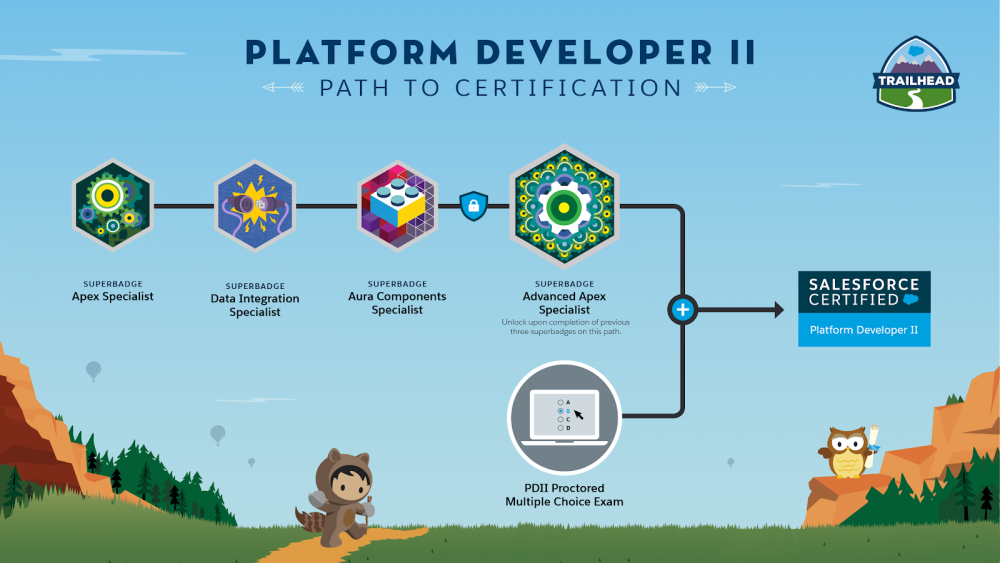Whether you are starting in the world of Salesforce development or you have been a Salesforce developer for some time, it is time to start considering getting certified. We have two developer certifications. Prepare first for Platform Developer I certification, and prove you have the skills to be a great Salesforce developer. Did you pass? Then give Platform Developer II a try and demonstrate that you are a Salesforce development rockstar!
Why get certified?
Preparing to get a certification will require you to invest some time in studying. However, obtaining a certification has a lot of benefits — not only after you have passed the exam, but also during the preparation process.
- LEARN: Preparing for a certification is one of the best ways to learn. When you study for a certification, you discover features you hadn’t heard about before, and you find new ways of using capabilities you already know (e.g. a formula function that may save you lots of time!).
- EARN: Owning a certification allows you to demonstrate your level of expertise more professionally. You can link your credentials in your LinkedIn profile or mention them on your CV or resume.
- CONNECT: Studying for a certification brings you the opportunity to connect with other developers. Look for certification study groups in the Trailblazer Community, and join them.

Superbadges for the knowledge win
Most certifications are obtained by acing a multiple-choice exam. However, some certifications have additional requirements. For example, to obtain the Platform Developer II certification, you will need to complete four Superbadges and the multiple-choice exam.

Superbadges are earned via Trailhead. You are given a business case, and you have to implement solutions for different requirements. Once finished, you check in Trailhead if the implemented solution is correct, as you do with any other Trailhead content.
When going for a Superbadge:
- Read the requirements carefully. Take pen and paper and draw. What is the object model? Which systems apart from Salesforce are part of the solution and how do they interconnect? Which business problems do you have to solve? Do you have to build any UIs?
- As Superbadges are not proctored and don’t have time requirements, you can do them progressively, and stop to clarify topics and clear up your doubts in your own time. However, don’t let too much time pass you by, because you may forget the requirements and the progress that you had made and have to rethink everything again.
- It is a good idea to commit your code to a personal repository, so that you can review it later.
Tip: Address the Superbadges before the test, as this will help when you study. Superbadges will also help you assess if you are ready to take the exam.
What content does the exam cover?
All Salesforce certifications have a corresponding exam guide, such as the Platform Developer I and Platform Developer II certifications exam guides. Exam guides contain an outline of which topics are covered by each exam and the percentages of questions that the test will include by topic. These are the exam guide topic percentages for Platform Developer I and Platform Developer II certification exams:
| Platform Developer I | Platform Developer II | |
| Salesforce Fundamentals | 10 % | 8% |
| Data Modeling and Management | 12 % | 5% |
| Logic and Process Automation | 46 % | 20% |
| User Interface | 10 % | 20% |
| Performance | 0 % | 15% |
| Integration | 0 % | 14% |
| Testing | 12 % | 13% |
| Debug and Deployment Tools | 10 % | 5% |
Much of the developer certifications are focused on logic and process automation. By learning about these, you will be able to better understand how to use all of our click tools and know when to start writing code. You will champion Execution Order in Salesforce, know how transactions work and deeply understand how automated processes and code can affect each other. You will learn how to create an extensible and effective data model that integrates perfectly with the Salesforce application sObjects. With newfound Governor Limit knowledge, your Apex code will be much more effective. You will take in how to create great UIs that extend the Salesforce application, making the most of Salesforce as a platform. You will ground yourself in writing automated tests for your code so that bugs that appear in the future are easily detected and code quality is maintained over time. Getting your application to production is also key, which is why you’ll learn how to deploy to different environments. Finally, you’ll explore a bit of Heroku, which is part of the Salesforce platform and can be a great option to externalize high load processes or build external UIs. For the Platform Developer II certification, you’ll go a step further and digest the basics of the platform integration capabilities and sharpen how to improve your code and page performance.
Obtaining a developer certification will empower you to create better and faster, because you will better understand the depth of what the platform can do and you will know the tools that will help you out.
Tip: Is there a topic which is not clear to you? I recommend that you get hands-on with a developer org. This is the best way to learn and to remember how things work.
Next steps
Preparing to get certified? This is what you can do next:
- Study on your own. There are lots of Trailhead modules, projects and superbadges you can start with. They are listed in these trailmixes:
- Register for an instructor-led course:
- Attend a FREE webinar and receive a certification voucher:
About the author
Alba Rivas works as a Lead Developer Evangelist at Salesforce. She focuses on Lightning Web Components and Lightning adoption strategy. You can follow her on Twitter @AlbaSFDC.